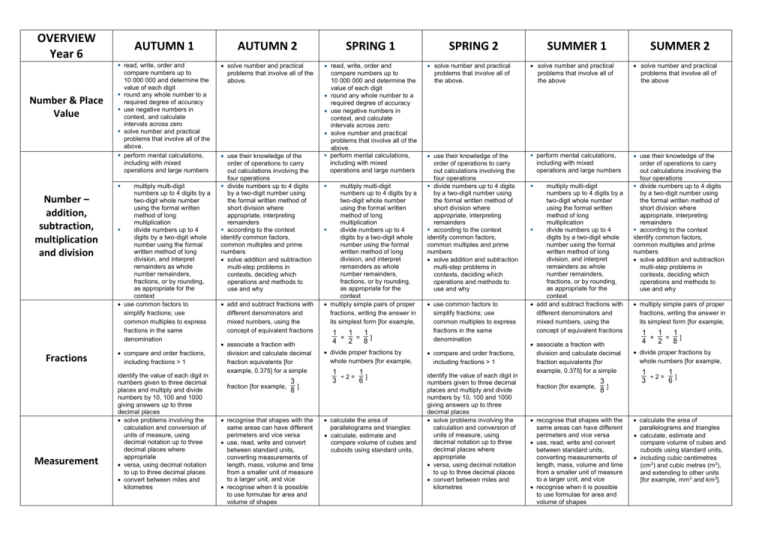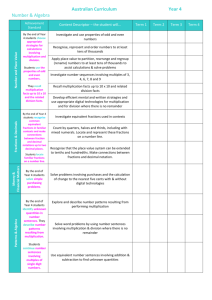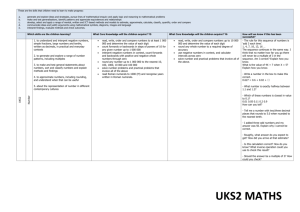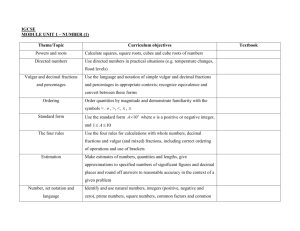Year 6
advertisement

OVERVIEW Year 6 Number & Place Value AUTUMN 1 AUTUMN 2 SPRING 1 read, write, order and compare numbers up to 10 000 000 and determine the value of each digit round any whole number to a required degree of accuracy use negative numbers in context, and calculate intervals across zero solve number and practical problems that involve all of the above. perform mental calculations, including with mixed operations and large numbers solve number and practical problems that involve all of the above. read, write, order and compare numbers up to 10 000 000 and determine the value of each digit round any whole number to a required degree of accuracy use negative numbers in context, and calculate intervals across zero solve number and practical problems that involve all of the above. perform mental calculations, including with mixed operations and large numbers Number – addition, subtraction, multiplication and division Fractions Measurement multiply multi-digit numbers up to 4 digits by a two-digit whole number using the formal written method of long multiplication divide numbers up to 4 digits by a two-digit whole number using the formal written method of long division, and interpret remainders as whole number remainders, fractions, or by rounding, as appropriate for the context use common factors to simplify fractions; use common multiples to express fractions in the same denomination compare and order fractions, including fractions > 1 identify the value of each digit in numbers given to three decimal places and multiply and divide numbers by 10, 100 and 1000 giving answers up to three decimal places solve problems involving the calculation and conversion of units of measure, using decimal notation up to three decimal places where appropriate versa, using decimal notation to up to three decimal places convert between miles and kilometres use their knowledge of the order of operations to carry out calculations involving the four operations divide numbers up to 4 digits by a two-digit number using the formal written method of short division where appropriate, interpreting remainders according to the context identify common factors, common multiples and prime numbers solve addition and subtraction multi-step problems in contexts, deciding which operations and methods to use and why add and subtract fractions with different denominators and mixed numbers, using the concept of equivalent fractions associate a fraction with division and calculate decimal fraction equivalents [for example, 0.375] for a simple 3 fraction [for example, ] 8 recognise that shapes with the same areas can have different perimeters and vice versa use, read, write and convert between standard units, converting measurements of length, mass, volume and time from a smaller unit of measure to a larger unit, and vice recognise when it is possible to use formulae for area and volume of shapes multiply multi-digit numbers up to 4 digits by a two-digit whole number using the formal written method of long multiplication divide numbers up to 4 digits by a two-digit whole number using the formal written method of long division, and interpret remainders as whole number remainders, fractions, or by rounding, as appropriate for the context multiply simple pairs of proper fractions, writing the answer in its simplest form [for example, 1 1 1 × = ] 4 2 8 divide proper fractions by whole numbers [for example, 1 1 ÷2= ] 3 6 calculate the area of parallelograms and triangles calculate, estimate and compare volume of cubes and cuboids using standard units, SPRING 2 SUMMER 1 SUMMER 2 solve number and practical problems that involve all of the above. solve number and practical problems that involve all of the above solve number and practical problems that involve all of the above use their knowledge of the order of operations to carry out calculations involving the four operations divide numbers up to 4 digits by a two-digit number using the formal written method of short division where appropriate, interpreting remainders according to the context identify common factors, common multiples and prime numbers solve addition and subtraction multi-step problems in contexts, deciding which operations and methods to use and why perform mental calculations, including with mixed operations and large numbers use their knowledge of the order of operations to carry out calculations involving the four operations divide numbers up to 4 digits by a two-digit number using the formal written method of short division where appropriate, interpreting remainders according to the context identify common factors, common multiples and prime numbers solve addition and subtraction multi-step problems in contexts, deciding which operations and methods to use and why use common factors to simplify fractions; use common multiples to express fractions in the same denomination compare and order fractions, including fractions > 1 identify the value of each digit in numbers given to three decimal places and multiply and divide numbers by 10, 100 and 1000 giving answers up to three decimal places solve problems involving the calculation and conversion of units of measure, using decimal notation up to three decimal places where appropriate versa, using decimal notation to up to three decimal places convert between miles and kilometres multiply multi-digit numbers up to 4 digits by a two-digit whole number using the formal written method of long multiplication divide numbers up to 4 digits by a two-digit whole number using the formal written method of long division, and interpret remainders as whole number remainders, fractions, or by rounding, as appropriate for the context add and subtract fractions with different denominators and mixed numbers, using the concept of equivalent fractions associate a fraction with division and calculate decimal fraction equivalents [for example, 0.375] for a simple 3 fraction [for example, ] 8 recognise that shapes with the same areas can have different perimeters and vice versa use, read, write and convert between standard units, converting measurements of length, mass, volume and time from a smaller unit of measure to a larger unit, and vice recognise when it is possible to use formulae for area and volume of shapes multiply simple pairs of proper fractions, writing the answer in its simplest form [for example, 1 1 1 × = ] 4 2 8 divide proper fractions by whole numbers [for example, 1 1 ÷2= ] 3 6 calculate the area of parallelograms and triangles calculate, estimate and compare volume of cubes and cuboids using standard units, including cubic centimetres (cm3) and cubic metres (m3), and extending to other units [for example, mm3 and km3]. Ratio and Proportion Algebra Geometry Position & Direction solve problems involving the relative sizes of two quantities where missing values can be found by using integer multiplication and division facts solve problems involving unequal sharing and grouping using knowledge of fractions and multiples solve problems involving the calculation of percentages [for example, of measures, and such as 15% of 360] and the use of percentages for comparison solve problems involving unequal sharing and grouping using knowledge of fractions and multiples solve problems involving similar shapes where the scale factor is known or can be found solve problems involving unequal sharing and grouping using knowledge of fractions and multiples. solve problems involving the relative sizes of two quantities where missing values can be found by using integer multiplication and division facts solve problems involving unequal sharing and grouping using knowledge of fractions and multiples solve problems involving the calculation of percentages [for example, of measures, and such as 15% of 360] and the use of percentages for comparison solve problems involving unequal sharing and grouping using knowledge of fractions and multiples solve problems involving similar shapes where the scale factor is known or can be found solve problems involving unequal sharing and grouping using knowledge of fractions and multiples. . use simple formulae generate and describe linear number sequences express missing number problems algebraically find pairs of numbers that satisfy an equation with two unknowns illustrate and name parts of circles, including radius, diameter and circumference and know that the diameter is twice the radius use simple formulae generate and describe linear number sequences enumerate possibilities of combinations of two variables draw 2-D shapes using given dimensions and angles recognise, describe and build simple 3-D shapes, including making nets compare and classify geometric shapes based on their properties and sizes and find unknown angles in any triangles, quadrilaterals, and regular polygons describe positions on the full coordinate grid (all four quadrants) draw and translate simple shapes on the coordinate plane, and reflect them in the axes express missing number problems algebraically find pairs of numbers that satisfy an equation with two unknowns recognise angles where they meet at a point, are on a straight line, or are vertically opposite, and find missing angles. use simple formulae generate and describe linear number sequences enumerate possibilities of combinations of two variables draw 2-D shapes using given dimensions and angles recognise, describe and build simple 3-D shapes, including making nets compare and classify geometric shapes based on their properties and sizes and find unknown angles in any triangles, quadrilaterals, and regular polygons describe positions on the full coordinate grid (all four quadrants) draw and translate simple shapes on the coordinate plane, and reflect them in the axes express missing number problems algebraically find pairs of numbers that satisfy an equation with two unknowns illustrate and name parts of circles, including radius, diameter and circumference and know that the diameter is twice the radius recognise angles where they meet at a point, are on a straight line, or are vertically opposite, and find missing angles. draw 2-D shapes using given dimensions and angles recognise, describe and build simple 3-D shapes, including making nets compare and classify geometric shapes based on their properties and sizes and find unknown angles in any triangles, quadrilaterals, and regular polygons describe positions on the full coordinate grid (all four quadrants) draw and translate simple shapes on the coordinate plane, and reflect them in the axes. Statistics Using & Applying Solve problems involving +/-/x/÷ in different contexts. interpret and construct pie charts and line graphs and use these to solve problems calculate and interpret the mean as an average. Solve problems involving +/-/x/÷ in different contexts. Solve problems involving +/-/x/÷ in different contexts. interpret and construct pie charts and line graphs and use these to solve problems calculate and interpret the mean as an average. Solve problems involving +/-/x/÷ in different contexts. Solve problems involving +/-/x/÷ in different contexts. interpret and construct pie charts and line graphs and use these to solve problems calculate and interpret the mean as an average. Solve problems involving +/-/x/÷ in different contexts.






